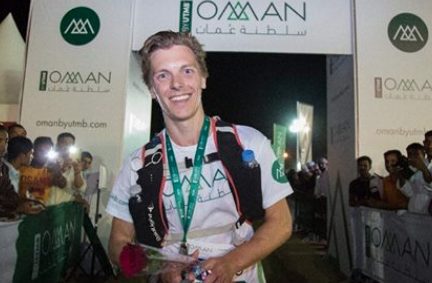Jason Schlarb won UTMB Oman on an low-carb, high-fat diet, says fifth place finisher
A recently Daily Telegraph article reveals ultrarunners enjoying considerable success on a diet containing very little carbohydrate

The case for the low-carb, high-fat (LCHF) diets and their application to ultra-endurance running was bolstered recently when Alfie Pearce-Higgins, who finished fifth at this year’s inaugural UTMB Oman, revealed in the Daily Telegraph that both he and winner Jason Schlarb (who shared the win with Swiss runner Diego Pazos) trained and raced on a mainly low-carb diet.
RELATED: First Oman by UTMB ultra ends in a tie
UTMB Oman is 137K through rocky mountain trails in the southeast Arabian peninsula, with 7,800m of cumulative ascent. This was the first time Pearce-Higgins had attempted to run an ultra fuelled mainly on fat and protein. He did so at the suggestion of Dr. Tim Noakes, the controversial South African scientist who is one of the main proponents of the LCHF diet. For years Noakes has disputed the almost universal belief that carbohydrate is necessary for fuelling, and recommends that endurance athletes avoid carbohydrate altogether.
RELATED: Fat adaptation: what does it mean for runners?
Schlarb confirmed this in an email: “I’m not “religious” on being low-carb,” he told us. “I eat fresh fruit, and from time to time, especially while I travel, I don’t have a problem with eating outside my diet.”
Schlarb first experimented with cutting down on carbs in 2013, because he was having trouble fuelling for long ultras without having gastric issues. “By reducing carbs in my diet by reducing processed sugars and grains, I became more fat adapted,” he goes on. “By being better fat adapted I didn’t need as many carbs in training and racing, thus eliminating my fueling issues. Five years later I have realized many more benefits by being lower carb in my diet. I feel better all day long, more consistently even in peak training, and don’t get as moody and “hangry” as I did when I was carb-heavy. My body is leaner… and overall I am much happier.”
The theory is based on the idea of training the body to burn fat instead of carbohydrate for fuel, since the body can store a great deal more fat than it can carbohydrate, which typically must be replenished as often as every 30 minutes, and in most people is completely depleted after a couple of hours of running.
Pearce admits the research on the subject is conflicting. Many scientists have long believed studies that show a high-fat diet that also contains a lot of animal protein is associated with higher rates of heart disease. However, he told us “it is worth noting that many of these… do not show a causal link [between high fat consumption and health problems]. Given that eating high fat has traditionally be correlated with lots of other behaviours (smoking, drinking, lack of exercise), it is very hard to disentangle any dietary effects.”
With so much conflicting advice, Pearce-Higgins writes in the Telegraph story, “there seemed little alternative than to put the theory to practical test. For six weeks [leading up to the race] I, along with my long-suffering partner, attempted to cut out all carbs and switch to a high-fat diet.”
https://www.instagram.com/p/BqzfcC2AtZD/
A typical breakfast consisted of bacon, eggs and avocado. Lunch included meat and cheese and nut salads. Dinner: meat and vegetables. He says he was “shocked” at how easy it was, and he no longer had the gnawing hunger he used to experience when relying on carbohydrate for fuel. “I now found myself content with three modest meals daily despite a heavy training workload. Far from fighting the urge to snack, I simply wasn’t hungry.”
(In the article, the diet is referred to as Banting, for undertaker William Banting, who pioneered its use for weight loss. He was a distant relative of Sir Frederick Banting, discoverer of insulin.)
RELATED: Canadians run 24 hours in sensory deprivation on Spartan Worlds site
After running through the night, according to Pearce-Higgins, almost 40 per cent of the 324 racers had already DNF’d–even some who had successfully completed the original UTMB at Chamonix, considered one of the toughest races in the world. He did stop for a meal of rice, lentils and chicken at one point, and also had some bananas and dates, but he mostly passed up the sugary snacks offered at most of the aid stations. After 23 hours, he finished–in fifth place, far better than he expected. His Strava told him he’d burned nearly 20,000 calories (and he consumed 3,000).
Pearce-Higgins admits the research is confounding and sparse, and that even his interaction with Noakes could have had a placebo-like effect. He also would never claim that the LCHF diet made him faster, simply that it helped him deal with many of the issues common to those who rely on carb-fuelling: hunger, gastrointestinal issues, and the concern about consuming sugar. Still, it’s a startling result, and one that bears consideration. For himself, he says, “I certainly won’t be reaching for an energy gel anytime soon.”


